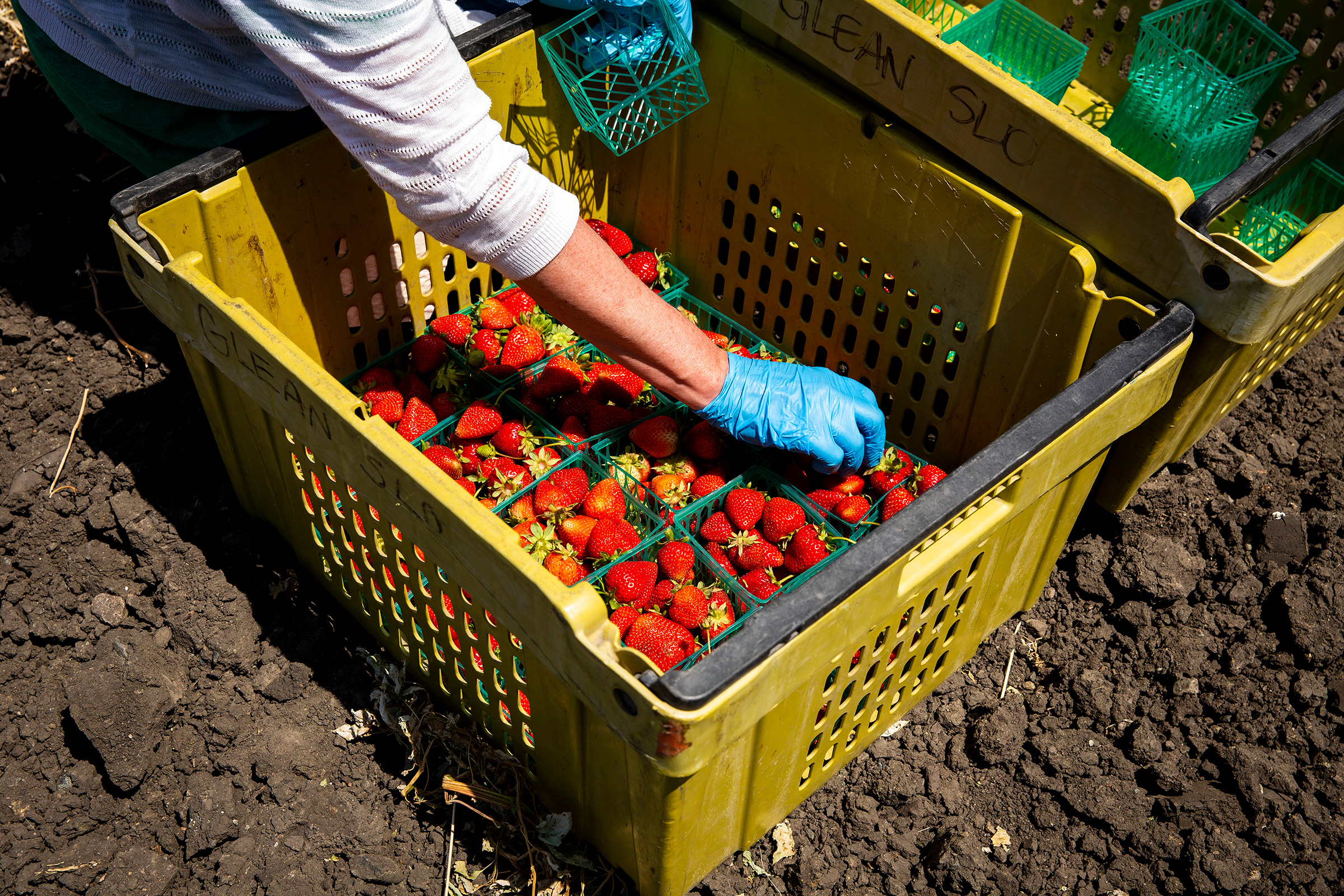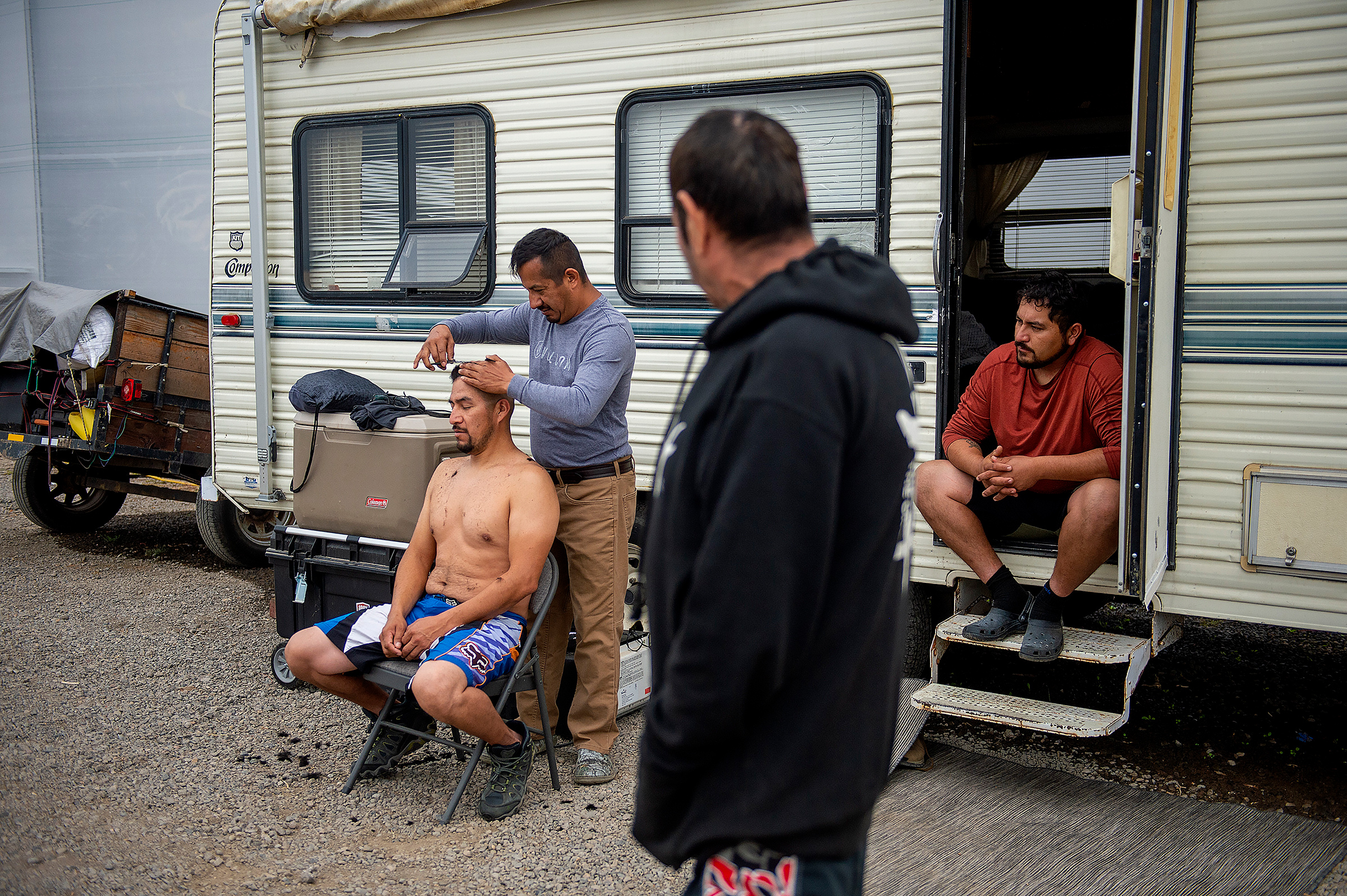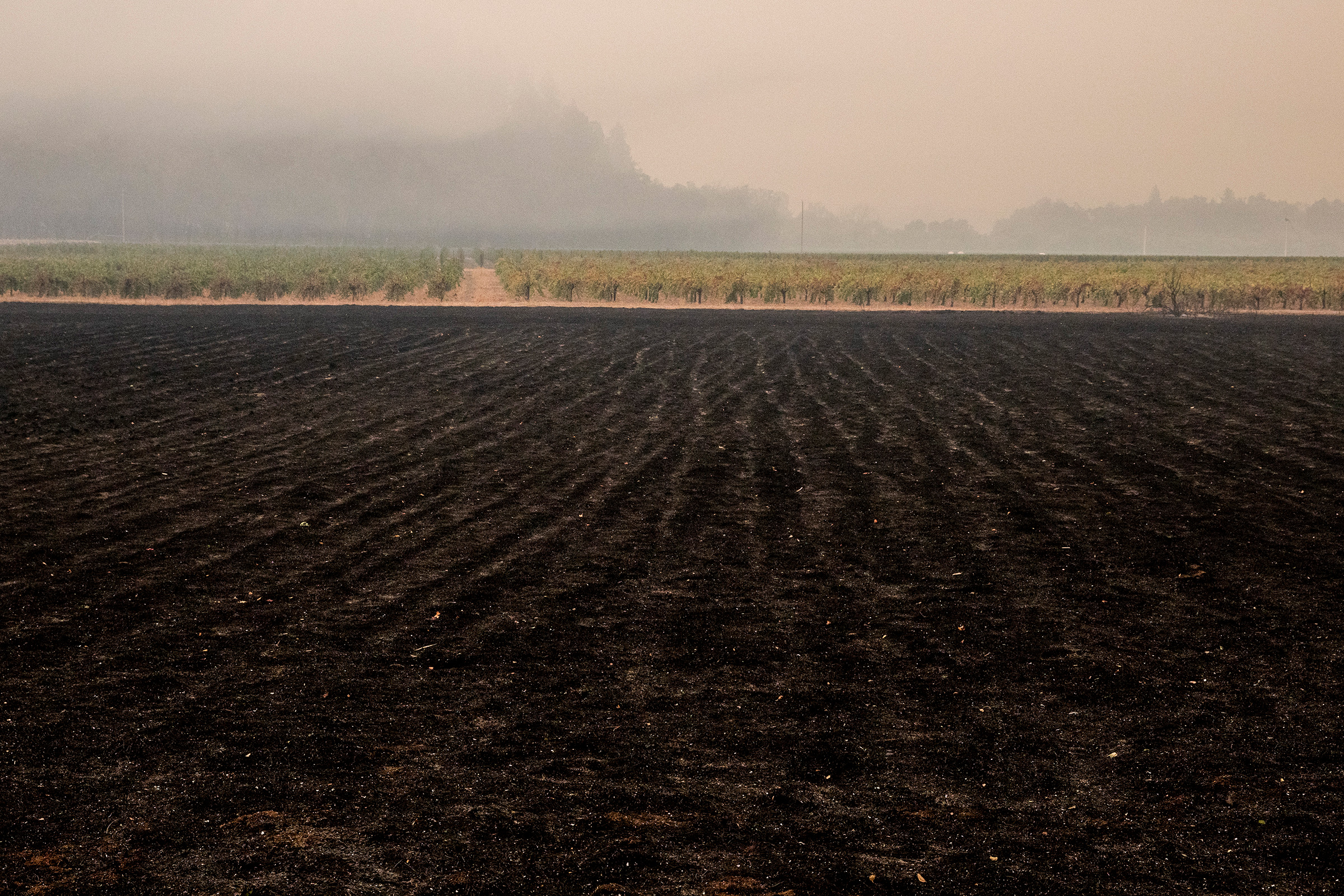Larry Tristano is looking out over what used to be his lush 13-acre farm in Santa Rosa, California. Less than a month ago, the fields were full, and he and his small team at Triple T Farm were harvesting cherry tomatoes, peppers, eggplants, and squash.
Now, there’s nothing but burnt ground. On Sept. 27, two raging Northern California wildfires, the Glass and Shady fires, converged, rapidly burning thousands of acres. The family homes on the property—where he and two more generations of his family lived—were burnt into ash; so were the barns, tools, livestock, an SUV and more. “After the fires in Paradise, I drove through and said, ‘I feel so sorry for these people.’ But you’ll never know how anybody feels until you’ve gone through it,” Tristano says, choking back tears. “It’s just horrible.”
Up and down the West Coast, farmers are reeling from a hellish summer of consecutive and overlapping crises. First, COVID-19 spread across the country, endangering the lives of farmworkers who were deemed as essential and devastating the restaurant market. Record-breaking hot stretches, which made this August the hottest one on record in California, burnt crops and decreased yields. Then a new wave of fires descended across the forests and hills, displacing workers, demolishing homes and blanketing regions with stifling smoke. “We’re trying to put the best food on the table and it’s been very, very rough,” Tristano says.
While some might chalk up these events to a series of freakish aberrations, there are signs that none of these crises will disappear anytime soon. Climate change is facilitating record-breaking heat spells; fires are raging every season in part due to poor forest management; many employers are resigned to COVID-19 lingering through the start of next year’s planting season. Once a land of bounty, the Golden State has turned into an unrelenting minefield of obstacles that have exposed the many flaws of an entire ecosystem.
As West Coast farmers and farmworkers start thinking about long-term solutions, they are often stumped. “We’re focusing on ‘How I get through today,’ but this might be what California looks like every August and September,” says Lorraine Walker, who runs Eatwell Farms in Dixon, California. “I have spoken with a few farmers and asked them, ‘What are you planning? Everyone’s response is, ‘We don’t really know.'”

COVID-19’s “Rollercoaster Ride”
The agricultural output of the West Coast is massive. California’s Central Valley grows a staggering quarter of the nation’s food and 40% of its fruits, nuts and other table foods. Oregon raked in $238 million in 2019 from wine, while Washington produces 65% of the nation’s fresh apples. If you buy a piece of produce from your typical American supermarket, there’s a good chance it came from a West Coast farm.
But the state of farms in the United States was precarious even before COVID-19 struck earlier this year and plunged the nation into a recession. In 2019, the number of farms filing for bankruptcy increased 24% from the previous year, while the U.S. farm debt grew to $425 billion. Foreign competition, trade wars, regulations and unpredictable weather made life hard on farmers. In California, massive wildfires ripped through expanses of fields that grow wine grapes, tomatoes and other goods.
COVID-19 added a new chaotic layer of unpredictability. “It’s been a rollercoaster ride, from panic buying to loss of demand to the food service business disappearing,” says Joe Pezzini, the president and CEO of Ocean Mist Farms, which is based in Castroville, Calif. “Every day’s been a new challenge.” Some farms took a huge hit from the loss of critical buyers like restaurants and school systems; others were buoyed by the increased interest in home cooking with fresh produce. The decreased price of many crops hit some farmers hard; others were able to float through thanks to government loans. As farmers realized they had excess supply, they dumped milk, slaughtered livestock and smashed eggs.
Regardless of COVID’s impact on a farm’s bottom line, the workforce bore the brunt of the risk. There are 400,000 agricultural workers in California, a population that was deemed essential during the pandemic. Researchers and advocates estimate between 60% and 75% of them are undocumented, and a majority are Latinos. Their typical lack of unionization and the constant fear of deportation have long made them vulnerable to workplace coercion. “The inequities that COVID-19 has highlighted, they existed pre-COVID,” Estella Cisneros, the legal director of the Agricultural Worker Program at California Rural Legal Assistance, Inc., says. “There’s a lot of pressure on farmworkers to continue working, and a lot of fear of retaliation.”
This year, Cisneros says that her office has fielded many complaints from California farmworkers who say their employers are not taking proactive steps to protect them or are simply ignoring Cal/OSHA regulations about protective equipment. “Some workers said that instead of being given masks, they were given something that much more resembled hairnets,” she says.
Many of the farmworkers that the CRLA assists are part of an aging population, have preexisting conditions like heart disease and diabetes, and have little access to healthcare or job alternatives. Harrowing statistics have confirmed how vulnerable Latino populations are to the virus: In California, they represent 61.1% of COVID-19 cases and 48.6% of deaths, despite making up only 38.9% of the population. “It’s highlighted how at the mercy these workers are at the hands of people who are not the workers themselves,” Cisneros says.
In Oregon, Reyna Lopez, the executive director of the farmworker union PCUN (Pineros y Campesinos Unidos del Noroeste), says that a quarter of farmworkers polled in a member phone survey said they hadn’t seen any improvements in safety measures being taken by employers. “We’ve also heard that enforcement of the rules isn’t good—and when there is a complaint, people aren’t seeing it getting investigated,” she says.
Lopez and Cisneros are both fighting for the extensions of OSHA regulations related to COVID-19 in their states. They worry that the virus will continue to spread through vulnerable communities if workers are kept in packed labor housing units and sent out into the fields and processing plants in unsafe conditions, especially once the season picks back up next spring. “We have to be ready for May, when we’ll see lots of people coming for the harvest,” Lopez says. “This year, that’s when we saw a lot of outbreaks.”

A Record-Breaking Heat Wave
Some farm owners have viciously complained about regulations like a rising minimum wage and water restrictions, saying they are squeezing their already meager margin of profit. “The costs are becoming so exorbitant, you’re seeing a lot of ground be idle or sold to other growers,” says Bruce Blodgett, the executive director of the San Joaquin Farm Bureau Federation. “People seem to forget we compete in a world marketplace that doesn’t have the labor or regulatory costs we do. Farmers are saying, ‘I’ve had enough, I can’t compete.’”
While Blodgett and others fight a battle over regulation, they’re also getting hammered by increasingly chaotic weather systems. Blodgett says that heavy rains during cherry harvest season in May slashed the potential cherry revenue in half. Then a record-breaking scorching summer set in, threatening both the crops and the ability of farmworkers to work in the face of heat exhaustion. In August, nearly 14,000 lightning strikes hit California over a 72-hour period. In early September, L.A. County hit an unprecedented 121 degrees.
Some 300 miles north of Los Angeles on the central coast of California lies Taylor Farms, which produces salads and vegetable kits and racks up billions a year in total sales. For the last two decades, Taylor Farms’ crops have thrived in the moderate climate of Salinas, where the coastal breeze and fog suppress summer temperatures and allow leafy greens to thrive.
But this year, record high temperatures hit Salinas once again, forcing Taylor Farms into a work schedule they’ve never tried before: complete night shifts, with workers reporting at midnight and working through 6 or 7 in the morning. “We kept people as cool as we could. At the same time, it was an awful rough six weeks for everybody who’s in this business,” Mark Borman, the president of Taylor Farms California, says. Despite the change, Borman says the company has lost about 23% of its projected yield over the last four weeks due to the heat wave.
Ocean Mist Farms, which specializes in artichokes and brussels sprouts and operates in the same area, was similarly impacted. “Lettuce gets burn on it, and there may be a supply issue coming up for Thanksgiving,” Pezzini, the CEO and president, says. “You have to salvage what you can.”
Bigger companies like Taylor Farms and Ocean Mist have some flexibility to deal with climate change: they can simply alter or move their operations. Pezzini hopes to move his artichokes and brussels sprouts closer to the coast where it’s cooler, and has been using drip irrigation in order to combat the water drought plaguing the state. Borman is looking at his options outside the state entirely. “Today, we grow more and more lettuce in Central Mexico. We’re growing more in Colorado,” he says. “We want to diversify our growing regions, so as things continue to change, we’ll have the right development from a seed perspective and have some flexibility.”
But smaller farmers aren’t afforded the same adaptability. Walker, at Eatwell Farms, says her tomato crop was “beyond disappointing” this year due to the combination of an extremely hot August followed by weeks of smoke blocking the sun. She says she might plant her tomatoes earlier in the season when it’s cooler—but that would impact the planting of her winter crops before it. “We don’t have much wiggle room,” she says.

“The Sun Didn’t Rise”
While rising temperatures threaten livelihoods, they mostly don’t threaten actual lives. But the fires that follow the heat waves do. Over five million acres have burned in California, Oregon and Washington combined during what has been the most active fire year ever on the West Coast. Experts say that climate change, lightning strikes and poor forest management have combined to provide the kindling for infernos that have killed over thirty people and destroyed thousands of buildings.
Kendra Kimbrauskas, the co-owner Shimanek Bridge Farm near Scio, Oregon, had previously not thought much about the risk of fires when in September, she woke up to a strange sight. “The sun didn’t rise. It was black like it was midnight,” she recalls. “The ash was falling, and it looked like it was in the middle of winter, with snowflakes in your headlights. At like 11 a.m., the sun finally came through and turned everything a really eerie red—like blood red.”
Kimbrauskas hooked up her horse trailer and headed to the county fairgrounds, where she stayed for almost a week. While her farm was ultimately untouched by the fires, many were not—and she dove into a community rescue effort to save the many animals that had been left behind. She ended up using her truck and a trailer to transport abandoned animals to the Linn County Expo Center, where a noisy scene was developing. “We’re talking hundreds of farms, thousands of animals,” she says. “It was like Noah’s Ark, with any animal you can imagine that people were scrambling to get out of danger: horses, sheep, bunnies, ducks, geese, alpacas.”
Kimbrauskas says she has committed to regenerative farming practices that will hopefully lead to more fire-resilient farms. But this experience has shown her how even the best preventative measures may not be enough. “We also have to be prepared to just leave,” she says. “If we don’t have a plan, we may lose our lives.”

Lopez, of PCUN, said that many farmworkers in areas adjacent to evacuation zones were still told to go back to work and endure hazardous air quality. “It’s really important for people to understand there were thousands of outdoor farmworkers still out there working while this was still happening,” she says. “We spoke to a farmworker, Manuel, who said that during the peak of the wildfires, he was feeling nauseated, had a headache, and his body was hurting. He’s still not feeling 100%.”
Many more lost their homes. In Phoenix, Ore., about 200 miles south of Scio, a wildfire ripped through a predominantly Latino community, destroying nearly 1,000 housing units, most of them mobile homes and RV parks. Many members of the community are agricultural workers who toil at the area’s food processing plants and wineries, and have nowhere to turn. “In less than five minutes, everything was gone,” Phoenix resident Jairo Gomez told the Washington Post.
Larry Tristano, in Santa Rosa, suffered the same fate. He himself was in Wyoming when the fire rolled through—but his family was still in their Santa Rosa house and scrambled to get out when they learned of the evacuation order. “My wife grabbed our parents’ wedding pictures, her mother’s scrapbooks, personal things, clothes, our dogs, and that was it,” he says.
Two days later, Tristano returned to nothing. “The only thing that survived was one greenhouse and the tractor. Everything else is gone,” he says. In response, he started doing the only thing he knows how to do: farming the land. “We got a generator. We hooked up the well. Our vegetable crops did survive, and we’re actually back at the market on a limited supply. We’re not going to let this beat us.” Over two weeks, over $29,000 has been raised on GoFundMe for the farm’s workers and its recovery.

While Tristano is plowing ahead, there are many signs that the triple crisis for West Coast farmers is far from over. In Washington, the apple crop will be up to 10% smaller than expected due to wildfires and extreme windstorms battering orchards. Economic recovery has been slow, and COVID-19 could very well be lingering when many farm workers return in full force to plant seeds in the spring, threatening their health and slowing down schedules. And federal assistance has been underwhelming: while President Trump has spearheaded record farm subsidies, most of the money has flowed to Southern states and big farms, a nonpartisan watchdog agency found.
Borman, of Taylor Farms, says these compounding issues could affect the consumer through higher prices or a decreased selection. Restaurants may start building their menus around less perishable greens, like cabbage or iceberg lettuce, to protect against volatility. He expects some farmers to move out of the region to greener pastures, “whether that be into central Mexico or even further south into South America.”
As far as how West Coast farmers are adapting to these looming struggles, Borman doesn’t have an answer. “It was a really tricky year. There’s a lot of uncertainty, but I don’t know if there’s a lot of strategy coming out of it yet,” he says. “Honestly, everybody’s a little shell-shocked right now.”
More Must-Reads from TIME
- Cybersecurity Experts Are Sounding the Alarm on DOGE
- Meet the 2025 Women of the Year
- The Harsh Truth About Disability Inclusion
- Why Do More Young Adults Have Cancer?
- Colman Domingo Leads With Radical Love
- How to Get Better at Doing Things Alone
- Michelle Zauner Stares Down the Darkness
Contact us at letters@time.com
